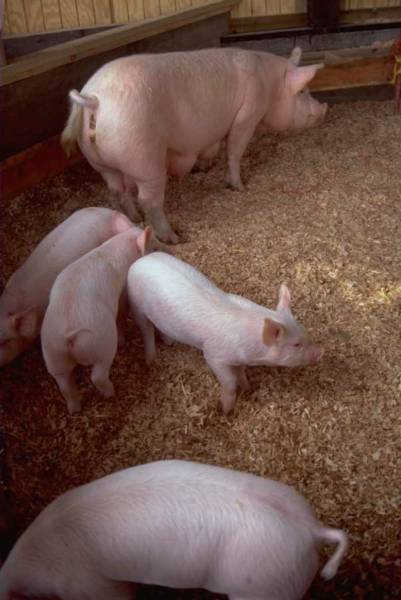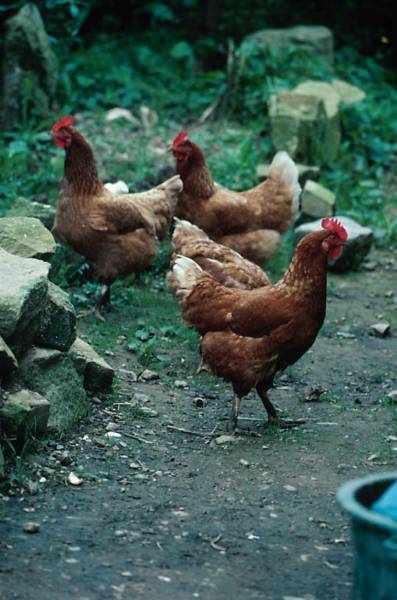
MEAT
I came for the produce, but have stayed for the meat. This is
the top of the food chain in which we are the next link. But the
health benefits would probably be quickly forgotten if the taste
wasn't so different -- not always (although usually) better, and definitely more interesting -- than familiar 'fake' meat
(see below).
Learning a bit about these animals has only increased my
enjoyment of sitting down to savor their flesh...
I came for the produce, but have stayed for the meat. This is
the top of the food chain in which we are the next link. But the
health benefits would probably be quickly forgotten if the taste
wasn't so different -- not always (although usually) better, and definitely more interesting -- than familiar 'fake' meat
(see below).
Learning a bit about these animals has only increased my
enjoyment of sitting down to savor their flesh...


Grass Dinner or Shot in the Neck? Using Drugs to Fight E. coli
12/4/09
In typical American fashion, Big Agriculture is trying to solve a bad habit with yet another bad habit. Like overdosing on aspirin to continue one's extended drinking binge, the U.S. Agriculture Department is now testing a drug to lessen E. coli outbreaks. More...
Spring Chickens have Sprung!
6/24/09
I have been obsessed with pastured warm-weather eggs for over a month. It’s time for the next natural step. The chickens! They are tasting so much yummier than last winter. They taste the way chicken is supposed to taste. More...
CAFO Source of Flu Pandemic
Raj Patel confirmed this theory yesterday at the Brooklyn Food Conference. The author of Stuffed and Starved had just returned from a trip to Mexico; he reported that 60 percent
of the people living around Smithfield’s enormous pig “concentrated
animal feeding operation" (CAFO) came down with mysterious flu-like
symptoms three weeks before US media was oink-ing about the sickness.
Pig Revenge?Does torturing our food supply result in human disease? We know it does with cows. How 'bout swine flu? More...
Leave Our Friend, the Steak, Alone
The NYT is giving beef the shaft again, with an article entitled The Price of Eating Red Meat. More...
Beef
If you haven’t worked with (or eaten) farmer’s market beef, stop reading, get up and go get yourself some. I’ll wait until you get back.
What’s the hurry? You’ve never had beef before. And is that anyway to live?
Okay, sure you’ve had steak and burgers that were plenty scrumptious but they did not come from a true cow. Or at least not a cow that felt like a cow.
To illustrate, let’s take you – a reasonably healthy individual who exercises when possible and likes good fresh food. Let’s force-feed you Cheetos, Pringles, Twinkies and some human jerky sticks until you feel very ill, until your immune system shuts down and your body begins to revolt. Now, instead of letting you go for a walk and find a salad, we fence you in, pump you full of antibiotics and make you to stand in your own shit, while your head is buried in cheese puffs.
At this point, I have to ask, do you feel like a human?
No, you’ve become a flesh manufacturer. Albeit a very sick one.
This is the life of most American cows. The resulting beef is as unnatural as trans fat slathered Styrofoam.
Real meat is raised not produced. So unless you have had grass-fed beef, you haven’t had beef. It’s more than the difference between a Twinkie and a homemade cupcake (be honest, which one feeds your soul?) but that’s part of it. The benefits of eating Real food reverberate in many directions – too many to get into here. (But I highly recommend Pollan’s books on this subject.)
Enough preaching: This site is for the more carnal senses.
Grass fed beef, first of all, looks different than fake beef. When raw, it is a dark magenta color – much darker than the rose color you find in the supermarket. And the texture between your fingers is supple, almost silky. The fat peels off easily – but do not throw this away. It is where all the yummy Omega 3s are and is my favorite way to grease a sauté pan.
(I think eating the fat of an animal is important, with the caveat that the animal must be healthy. In any properly functioning body, the balance of hormones and other nutrients is divided between muscles and fat tissue. If you only eat one or the other, you could be disrupting this balance in your own body. I am not a doctor; this is simply my own take on the most recent scientific literature…)
Two things to note when planning a recipe with Real beef:
1) The flavor is so luscious, you will savor it longer and therefore be deeply satisfied by a smaller portion.
2) There is less fat over all in the real cow (i.e. the grazing cow) than in the beef-manufacturing machine (i.e. the sick, shit-standing, fake-food-gorging cow). Reduce cooking time in standard recipes by one-third (muscle temp rises faster than fat) and keep the oven or stove temp slightly lower than you usually would.
Drunken Cow with Mushrooms
- I owe the idea to combining whiskey and soy sauce to a Brooklyn-based volunteer for Arcadian Pastures (Sloansville, NY).
Serves 2
Main Ingredients
½- ¾ lb grass-fed beef, preferably sirloin but other cuts will do nicely too
½ lb shitake or oyster mushrooms, sliced in half if large
¾ cup paper-thin slices of daikon (Japanese radish)
Marinade
¾ cup whiskey
¼ cup soy sauce
1 Tbs Campari (optional)
1 Tbs molasses
1 teaspoon fennel seeds
splash of juice, whatever you have in your fridge
Mix marinade ingredients and, if necessary, let beef defrost in it. Separate (but save!) fat. Cut beef into mouth-manageable strips and place back in refrigerated marinade for at least 40 minutes and up to 9 hours, the longer the better.
Twenty minutes before ready to eat, take fat out of marinade and let melt in large skillet until pan is well greased. Remove. Add mushrooms and then daikon, sautéing until soft.
Meanwhile, drain most of the marinade into small pot. Boil to reduce. You want about a quarter cup.
Add beef to mushroom mixture. Sauté until mostly brown, med-rare. Add reduced marinade. Serve.
(To use up the rest of the daikon, I diced it into long slices – with the critical help of a mandolin – and tossed with rice vinegar. A simple side dish to accompany the complexity above).
Turkey
I recently learned from Ms. Kingsolver’s book, Animal, Vegetable, Miracle, that turkeys have been bred to be so stupid they don’t even know how to mate.
Really. They would die out in one generation if we stopped artificially inseminating them. Imagine how much work that must be for the turkey farmer. Acting like some bee going flower to flower – although it is not quite so pretty. He or she must force the turkey tom to donate sperm (if you really need a visual: http://www.youtube.com/watch?v=skfiLfZltS4&feature=related) and then insert it into the tom-ettes. For every new batch of babies.
Leaving alone the deformities and physical problems (such as difficulty walking) of being bred to have as big a breast as possible, the fact that they can’t even have - or want - sex seems to me a vital blow. On a scale from 1-10, ten being full of life and one being dead, I give them a three. Conventional turkeys are the equivalent of Frankenstein.
Fortunately, not all turkeys are like this. Just 99.99 percent of those Americans eat.
The .01 percent is America’s heritage turkeys, bred locally for hundreds of years with emphasis on flavor, beauty and meat yield, according to the Heritage Turkey Foundation. Heritage turkeys withstood the trials of natural selection, sexual selection AND human selection. Conventional turkeys – of which there is only one type and that is Broad-breasted White (sometimes called Nicholas) – have only been vetted by the latter.
When it comes to choosing the best, I agree with Obama: the more vetting the better.
Check out some of the names of heritage turkeys: Bourbon Red, Jersey Buff, Slate, Black Spanish, White Holland, Royal Palm and White Midget. I feel like I’ve entered an international crime novel. Fitting, since most of these are in danger of being snuffed out. The only way to save them, paradoxically, is to eat them.
For a fascinating but quick read on the history of the turkey, go here.
While I like to believe that all the best things in the world are available at the farmers’ market, I was disappointed to learn that Di Paola’s Turkey farm, the biggest greenmarket turkey provider in NYC, raises predominantly conventional turkeys. These are yummy birds and I like that they are raised in more pleasant conditions than most mass-produced turkeys. (The life experience of any creature influences its flavor; science will back me up on that. More on that later.)
So, I will keep buying from Di Paola, but each time I will ask about heritage birds. Maybe if they get asked enough, they will raise some and give up that whole artificial insemination routine.
Di Paola’s sausage is delicious, and very lean – never more than 4% fat content. But here is what I did with a more challenging purchase: a large turkey back on special for $1.99.
Turkey Stew
Serves 3
1 turkey back
1 cup celery root, cubed
2 yellow onions, chopped
2-4 cloves garlic (larger amount if using local garlic), finely sliced
2 small carrots, chopped
5 stalks celery, chopped
2 Tbs rosemary, finally chopped
1/4 tsp ground tumeric (optional)
1/4 tsp ground cayenne (optional)
1 cup whey (optional)
1/4 cup milk
Place turkey back in Dutch oven or other large pot with lid. Fill with water until covered. Salt water and bring to simmer (small bubbles). Add all vegetables and spices. Continue to simmer for about one hour.
Remove turkey back and let cool enough to handle. Meanwhile, leave lid off simmering stock and allow liquid to reduce. Strip meat and set aside. (Reserve bones for future use.)
Add whey and milk (any kind other than soy) to simmering pot. If you want a smooth soup, puree at this point. Or leave alone for a chunky stew. Bring to a boil briefly. Add back turkey meat. Serve with toasted bread.
Urban Oven BBQ
4/27/09
In honor of the record highs for this time of year, we had an Urban BBQ yesterday. (You know, when you pretend you have outdoor space inside a city apartment.) Just after one p.m., a heavily marbled brisket... More...
Coco-Turkey Legs
4/19/09